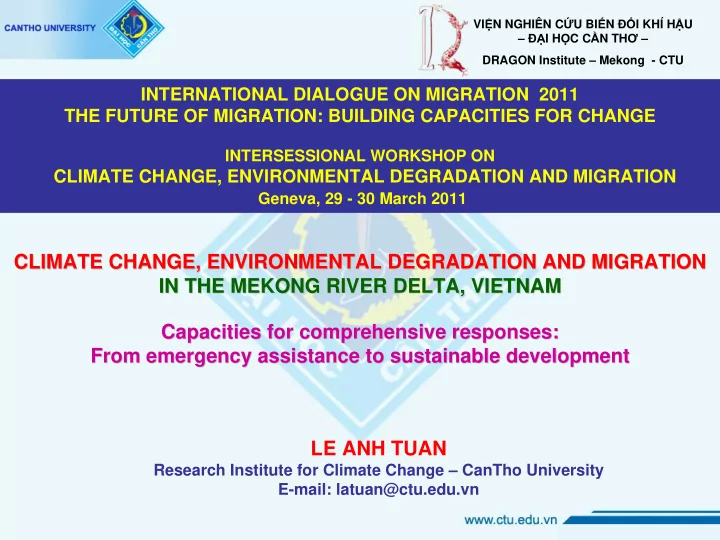

VI Ệ N NGHIÊN C Ứ U BI Ế N ĐỔ I KHÍ H Ậ U – ĐẠ I H Ọ C C Ầ N TH Ơ – DRAGON Institute – Mekong - CTU INTERNATIONAL DIALOGUE ON MIGRATION 2011 THE FUTURE OF MIGRATION: BUILDING CAPACITIES FOR CHANGE INTERSESSIONAL WORKSHOP ON CLIMATE CHANGE, ENVIRONMENTAL DEGRADATION AND MIGRATION Geneva, 29 - 30 March 2011 CLIMATE CHANGE, ENVIRONMENTAL DEGRADATION AND MIGRATION CLIMATE CHANGE, ENVIRONMENTAL DEGRADATION AND MIGRATION IN THE MEKONG RIVER DELTA, VIETNAM IN THE MEKONG RIVER DELTA, VIETNAM Capacities for comprehensive responses: Capacities for comprehensive responses: From emergency assistance to sustainable development From emergency assistance to sustainable development LE ANH TUAN Research Institute for Climate Change – CanTho University E-mail: latuan@ctu.edu.vn
1. INTRODUCTION TO THE MEKONG DELTA 1. INTRODUCTION TO THE MEKONG DELTA The Mekong River Delta (MD), the most downstream part of the Mekong river, has 4 million ha in size (36,000 km 2 ) and hosts about 18,6 million inhabitants (2010), counted 22% of Vietnamese population. The delta supplies more than 50% of the nation’s rice and crop food, 65% of the total fish production, and 70% of tree fruits for domestic and export..
A A Border VN-CPC A - A 3.00 Đ ồ ng C ử u C ầ n 2.00 Bac Hau Ti ề n Tien Tháp Long Th ơ Liêu River Giang River East Sea 7o 1.00 0.00 - 1.00 - 2.00 - 12 - 15 m Not to scale - 15 - 20 m
2. CLIMATE CHANGE IN THE MEKONG DELTA The Intergovernmental Panel on Climate Change has identifed the Mekong Delta in Vietnam as one of three hardest-hit delta regions by climate change worldwide (IPCC 4th Assessment Report, 2007).
The Mekong Delta is the most vulnerable area where all the the entire population living within of under a 10 m low elevation coastal zone (LECZ). Sea level Land Pop. displaced rise (m) lost (%) (%) # 1.0 # 25 # 20 (3.5 mil.) # 2.0 # 50 # 75 (14 mil. )
2. CLIMATE CHANGE IN THE MEKONG DELTA Average max. temperature Average min. temperature
2. CLIMATE CHANGE IN THE MEKONG DELTA Number of hot days Annual precipitation
2. CLIMATE CHANGE IN THE MEKONG DELTA Change in annual precipitation Flood boundary
2. CLIMATE CHANGE IN THE MEKONG DELTA Climate trends Trends Dry duration prolonged � Wet duration shorted � Annual mean temperature � Heat waves � Precipitation in critical season � Abnormal rainfall in wet season � Upstream floods � Sedimentation � River bank erosion � Drought � Abnormal strong wind (Whirlwind) �
3. ENVIRONMENTAL DEGRADATION 3. ENVIRONMENTAL DEGRADATION ≥ 70 km C Ầ N TH Ơ 2005 2010 Low upstream flow leads the salinity intrusion to coastal areas more serious
3. ENVIRONMENTAL DEGRADATION 3. ENVIRONMENTAL DEGRADATION The change of river flows and sea level rise lead the riverbanks and coastal lines in serious erosion.
3. ENVIRONMENTAL DEGRADATION 3. ENVIRONMENTAL DEGRADATION Higher temperature and lower rainfall are main reasons leading forest fire in the Mekong Delta. Tropical forest area reduction made the environmental degradation more serious.
3. ENVIRONMENTAL DEGRADATION 3. ENVIRONMENTAL DEGRADATION The rapid population growth and near-river-living habits cause water environmental damage.
Effects of Dams in Upstream to Lower MD Dam construction will displace thousands and alter flood cycles and sediment levels downstream where millions people fish and farm 14
CLIMATE CHANGE AND TRANSBOUNDARY WATER SEA LEVEL RISE ISSUES UPSTREAM DAMS MEKONG DELTA INDUSTRIAL GROWTH WATER RESOURCES EFFECTS DEFORESTATION WATER TRANSFER WATER WATER WATER QUANTITY QUALITY DYNAMICS NATIONAL FOOD AGRICULTURAL LAND AND SECURITY THREATS PRODUCT REDUCTION POVERTY AND UNSTABLE INCREASES DIRECT/ INDIRECT ENVIRONMENTAL & NATURAL RESOURCES DEGRADATION
4. MIGRATION 4. MIGRATION Vietnam’s Migratory Patterns: • Highlands to Lowlands • Northern to Southern regions • Rural to Urban areas (Source: Oxfam Hong Kong, 2009)
4. MIGRATION 4. MIGRATION Other countries Remote rural regions Peri- Bigger Low lying Urban cities coastal areas Semi-arid lands Vietnam annual population increasing: • Normal growth: 0.8 – 1.0 % (whole country) • Mechanical growth: 2.4% (cities) and 3-4 % (big cities) (Uncontrolled migration)
Climate change – – Environmental degradation Environmental degradation - - Migration Migration Climate change
5. COMPREHENSIVE RESPONSE 5. COMPREHENSIVE RESPONSE • Rural development • Labor market intervention • Migration spatial planning to climate change adaptation Level • Disaster preparedness • Environmental improvement • National budget distribution • Migration survey • Capacity building • Policy consideration Time
5. COMPREHENSIVE RESPONSE 5. COMPREHENSIVE RESPONSE A NALYSIS 5A approach (Phân tích) A WARENESS A DAPTATION 5A (Nh ậ n th ứ c) (Thích nghi) A DVOCACY A CTION (V ậ n độ ng) (Hành độ ng) (Tuan, 2009)
Thanks for your attention Thanks for your attention
Recommend
More recommend